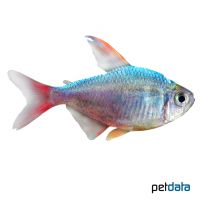Colombian Tetra (Hyphessobrycon columbianus)
| Colombian Tetra Hyphessobrycon columbianus | |
|---|---|
| Name | Colombian Tetra |
| Name Lat. | Hyphessobrycon columbianus |
| Family | Characins |
| Family lat. | Characidae |
| Order | Characins |
| Order lat. | Characiformes |
| Origin | Colombia |
| Habitat | Streams |
| Diet | Carnivore |
| pH | 5.0-7.5 |
| Behavior | Peaceful |
| Keeping | Group |
| Care Level | Moderate |
| Reproduction | Egg scatterer |
| Breeding | Moderately difficult |
| Life Span | 3-5 years |
| Protection | No |
| Metric Units | |
| Size | 5-6 cm |
| Temperature | 20-28 °C |
| Hardness | 1-15 °dH |
| Aquarium | ~ 60 l |
| US Units | |
| Size | 2"-2.4" |
| Temperature | 68-82 °F |
| Hardness | 18-267 ppm |
| Aquarium | ~ 15 gal |
Distribution and habitat
Red-blue Columbians are native to the Rio Acanti watershed in Colombia. They live in slow-flowing, small rivers and in the still water of streams with dense riparian vegetation as well as tree roots and branches protruding into the water.
Maintenance
The aquarium should have a varied, partly dense planting, with shelters and hiding places (roots) and provide sufficient swimming space. A dark substrate covered with some foliage (e.g. sea almond leaves), shaded light (floating plants) and a weak current is ideal.
No ammonia, ammonium and nitrite should be detectable, the nitrate value should not exceed 100 mg/l. To ensure the water quality and oxygen content, a filter and heater adapted to the aquarium size is required, as well as lighting for the species-appropriate day-night rhythm of the animals.
Diet
The food supply consists of live, frozen and dry food. For a balanced diet, feed once a day with a high-quality dry food (flakes, granules, pellets) as well as cyclops, daphnia, artemia, mosquito larvae, etc. (live or frozen). In addition, they need vegetable food, such as scalded spinach, crushed peas or commercial green food
It is recommended to feed small portions several times a day, which are eaten within a few minutes. A regular and varied diet promotes health and increases resistance.
Behaviour and compatibility
These lively fish live in groups and can be well maintained in a community tank with other small tetras, dwarf cichlids and armored catfish. Care should be taken when socializing them with shrimp. They should be kept in a group of 5-10 fish.
In principle, only mutually compatible fish species with similar requirements for water conditions and water temperature may be socialized.
Sex dimorphism
The more intensely colored males are more slender and have a somewhat extended and more pointed dorsal fin.
Reproduction and breeding
They are free spawners. In soft, slightly acidic peat water they usually spawn up to 400 eggs between fine-feathered plants. The larvae hatch after 24-36 hours and swim freely after about 4 days. The parents do not engage in brood care and should be separated from the fry after spawning, as they are spawn predators.
Fry must be fed several times a day with special rearing food (Artemia nauplii). Breeding is hardly possible in community tanks, as the spawn is easy prey.
Important
They are considered fin twitchers. Kept in a large enough aquarium and in a group, other fish are not bothered and their occasionally quarrelsome behavior remains intraspecific. Feeding with plant food reduces the risk of the fish eating the tender shoots of aquatic plants.
Foliage (sea almond, oak, etc.) enriches the water with humic substances, naturally lowers the pH, and is a valuable secondary food source.
The well-being of the fish should be monitored regularly. Temperature should be checked daily, pH, hardness and nitrate levels at least every 14 days. Regular partial water changes are recommended, even if the contaminant level has not yet reached the upper limit. Sudden changes in water quality should be avoided. Newly introduced fish must be accustomed slowly to the water in the aquarium.
Further literature can be found in your pet store.
References
Text: petdata; Image: petdata
Source: BMELV (1998): Tierschutzgutachten - Haltung von Zierfischen (Süßwasser); BAENSCH & RIEHL (1997): Aquarien Atlas Bd. 5, Mergus Verlag; ENGELMANN (2005): Zootierhaltung - Tiere in menschlicher Obhut: Fische, Verlag Harri Deutsch
- Gemäß § 21 Abs. 5 Tierschutzgesetz idgF
